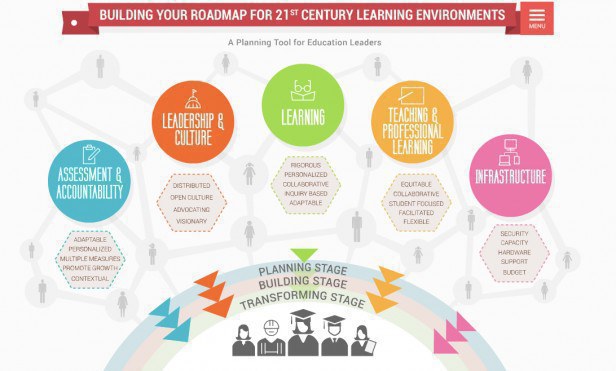Education leaders offer digital learning strategy tool at ISTE
 Classroom technology needs to play an equal part in a five-point strategic planning process as schools build 21st century learning environments, a group of education technology experts said Monday at the ISTE 2015 conference.
Classroom technology needs to play an equal part in a five-point strategic planning process as schools build 21st century learning environments, a group of education technology experts said Monday at the ISTE 2015 conference.
Technology shouldn’t drive digital learning, said Christine Fox, director of educational leadership and research for the State Educational Technology Directors Association.
But a school system’s infrastructure and broadband plans “need to be viewed on the same strategic level” and work together with four other dimensions of modern learning environments, she said. Those dimensions are outlined in a recently released “Roadmap for 21st Century Learning Environments.”
The roadmap is part of a strategic planning framework developed for school leaders by the Partnership for 21st Century Learning, SETDA and Cable Impacts Foundation. The framework focuses on five interrelated disciplines: assessment and accountability, leadership and culture, learning, teaching and professional development, and infrastructure.
Schools face “erratic training and support and a lack of funding, time and incentives,” to put together the “many puzzle pieces” that connect technology and learning, said Frank Gallagher, vice president of education for the Cable Impacts Foundation, a nonprofit representing the cable telecommunications industry.
The framework provides a series of principles, questions to explore and resources to help school leaders “plan, build and transform” their learning environments, he said. Because each school system is different, he said they “saw a need for a planning tool that would help education leaders create their own roadmaps for change.”
The resulting roadmap and associated resources are based on a review, numerous research studies and input from dozens of experts, said Helen Soule, executive director of the Partnership for 21st Century Skills, whose members include more than 20 partner states and two dozen organizations.
The jointly-developed framework attempts to provide planning tools for the emerging vision of education that relies heavily on technology but also represents a fundamental shift in the way teachers teach. The framework assumes that teachers are becoming facilitators of personalized learning and creative problem solving, enabled by high-speed broadband, powerful devices and digital content.
The infrastructure portion of the roadmap provides focuses on both the hard and soft sides of technology management, and principles for investing in infrastructure, including:
Capacity to ensure connections – Provides broadband for the school district, which includes connections among buildings, and copper and fiber infrastructure and Wi-Fi within buildings.
Hardware to accommodate any device that allows students to create content, consume content and/or connect and collaborate with others in the community or across the world.
Technical support, including the ability to fix broken devices and connections, maintaining all technology, planning for future problems and asset management.
Professional learning – Recognizes that the infrastructure will only be successful when those who use it are appropriately skilled, and therefore ensures adequate training and preparation.
Security – Ensuring infrastructure protects privacy and data security, and the means to address both the technical side and the human side, including policies around safety, what data can be used by whom for what purposes, and general digital citizenship are crucial.
Environmental – Coordinates and confirms the efficacy of the underlying infrastructure of schools, from the physical buildings to the electrical system.
Read more of StateScoop’s ed tech coverage from ISTE:
ISTE showcases startups, big brands and edtech products
Hot tech tools for today’s classrooms
Minecraft attracts long lines at ISTE conference





